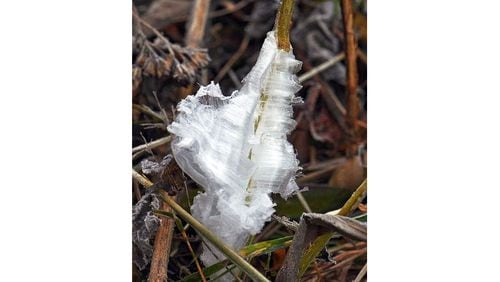On early frosty mornings in late fall and winter, when a thin rime of ice covers nearly everything in the landscape, my nature photography friend Don Hunter in Athens often gets up before the crack of dawn to go out and take photos of some beautiful, rare “flowers.”
Flowers in December? Actually, these are not real flowers, although they form on real plants. They are known as “frost flowers,” or “ice flowers.” Their formation requires a near-perfect blend of weather conditions and vegetation, which make them uncommon. They “blossom” during the night, when the air is just at freezing and the ground is warm — at least relative to the air.
During the formation process, cold water seeps out from vertical cracks that form in plant stems because of the frigid temperatures. The freezing air transforms the seeping water into paper-thin ice sheets that extrude from the cracks as white feathery curls and ribbons — frost flowers’ “petals.” Like snowflakes, no two frost flowers are alike.
Only a few plants, however, are conducive to forming frost flowers. In Georgia, native plants that commonly form the icy phenomena are white crownbeard or frostweed (Verbesina virginica) and yellow and purple ironweed or wingstem (Verbesina alternifolia). Both plants bloom around July in floodplains, woodland edges, unmowed roadsides and clearings in North Georgia. The white crownbeard also grows in several coastal plain counties.
Because they melt quickly with the rising sun and require special conditions, frost flowers probably go unnoticed by most people. But if you make a special effort to see them when the conditions are right, you can behold their breathtaking beauty. Photographers like Hunter love to capture them in pictures.
“They are beautiful and worth the effort of getting up before daylight and bundling up,” he said. He does nearly all of his frost flower photography near his home in Athens at the State Botanical Garden and Sandy Creek Nature Center, both of which have fairly large patches of white crownbeard.
IN THE SKY: From David Dundee, Tellus Science Museum astronomer: The Ursid meteor shower reaches a peak this weekend of about 15 meteors per hour in the eastern sky. The moon will be full on Tuesday night. Venus rises in the east a few hours before sunrise. Jupiter is high in the east at sunset. Saturn is in the southwest just after dark.
Charles Seabrook can be reached at charles.seabrook@yahoo.com.
About the Author






